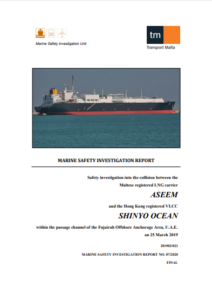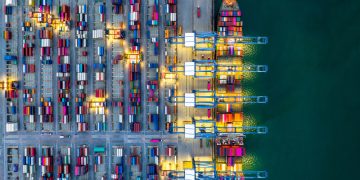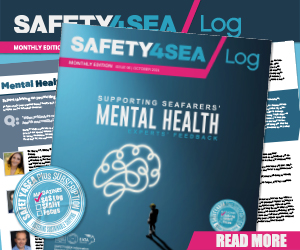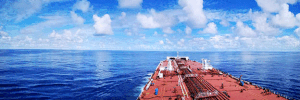Transport Malta’s MSIU issued an investigation report on the collision of the Maltese-registered LNG carrier ‘ASEEM’ and the Hong Kong-registered VLCC ‘SHINYO OCEAN’ in the passage channel of the Fujairah Offshore Anchorage Area, UAE, in March 2019.
The incident
During the night of 24 March 2019, MT Aseem was approaching the designated passage channel to the Fujairah Offshore Anchorage Area, UAE., while MT Shinyo Ocean was proceeding outwards through the same passage channel.
Aseem established contact with Shinyo Ocean over the VHF radio, and the two vessels mutually agreed on a suitable course of action.
Aseem conveyed to Shinyo Ocean that it would take a round turn to starboard in order to allow Shinyo Ocean time to leave the anchorage areas; while Shinyo Ocean conveyed to Aseem that it would be altering her course to port in order to leave the anchorage areas and proceed towards the Hormuz Strait.
Shortly after, the two vessels commenced their respective actions. Meanwhile, another vessel, which had just left the anchorage areas, was observed crossing ahead of Shinyo Ocean, at a close range.
Due to this situation, Shinyo Ocean altered course from the one conveyed to Aseem; thereby setting the two vessels on a collision course within a short span of time.
On 25 March 2019, at 00061 , Aseem and Shinyo Ocean collided.
As a result of the collision, the hulls of both vessels were breached below the waterline, with Shinyo Ocean sustaining extensive damages.
Probable causes
The safety investigation concluded that the immediate cause of the collision was communication between the two vessels over the VHF radio, which continued even when a close-quarter situation had developed, thus reducing the possibility of timely and effective corrective action until the collision occurred.
Conclusions
-Immediate Safety Factors
- Aseem and Shinyo Ocean were both communicating over the VHF radio. This communication continued even when a close-quarter situation had developed, thus reducing the possibility of timely and effective corrective action until the collision occurred.
- Shinyo Ocean was proceeding at a speed (in excess of that allowed by local regulations), which reduced the amount of time available for the bridge to take avoiding action while Silva was crossing ahead of her, as well as when a close quarter situation developed with Aseem.
-Other Safety Factors
- Shinyo Ocean’s departure was delayed due to problems encountered with weighing her anchor, which would have resulted in a delay at her arrival at her port of loading.
- The master of Aseem decided to take a round turn to starboard in order to allow Shinyo Ocean time and space to leave the anchorage areas, and thus avoid a close-quarter situation.
- From the VDR audio data, it would appear that Shinyo Ocean’s bridge was manned by the master, an OOW and a helmsman, from the time that the vessel’s anchor was aweigh until the time of the collision. No evidence was available to the safety investigation, which would indicate whether an additional look-out or an additional watchkeeping officer were present on her bridge.
- The bridge of Aseem was manned by the master, the third officer and two able seafarers – one of whom was acting as a helmsman. An additional watchkeeping officer was not present on the bridge, as was recommended by the Company’s SMS procedures.
Actions taken
During the course of the safety investigation, the Company identified a number of training needs for masters and navigating officers within the fleet. A number of safety actions were, therefore, adopted with the aim of preventing similar marine accidents in the future. These included:
- Ship Manoeuvring Simulation training courses are conducted for all masters and chief officers serving in the LNG carrier fleet, every five years;
- Large Ship Handling Simulation training courses are organised for masters joining LNG carriers, prior to their joining;
- All masters and chief officers serving in the LNG carrier fleet, are required to participate in Bridge Team Management courses every five years;
- A Behaviour-based Safety course for all officers serving on board the Company’s LNG carriers has been introduced within the Company’s own maritime training institute;
- A VDR dynamic analysis, consisting of a comprehensive review through observation of navigational practices during a voyage, conducted over a fixed period of time and involving a critical passage (such as a straits transit, pilotage or port approach), is being carried out at random, by a third party, on select tankers and gas carriers, to evaluate the human behaviour and activity of bridge team management towards compliance with the Company’s procedures and other regulations;
- Navigational audits are conducted out on board the Company’s fleet, in accordance with the below schedule:
- within 30 days of joining a vessel and every six months – an audit by the master,
- every year – an audit by a marine superintendent, and
- every year – a Static and Dynamic Navigational Assessment by a third party which also provides on-board training to all navigational officers;
- A case study on this accident has been prepared and circulated on board the fleet of vessels.
Recommendations
The MSIU has made a recommendation to the managers of Shinyo Ocean, designed to ensure that the safety and latent factors are brought to the attention of, and addressed with the masters and navigating officers within their fleets.
It also made a recommendation to the flag State Administration of Malta to emphasize the hazards involved in VHF radio communication between vessels, for the purpose of collision avoidance.
Explore more herebelow:



































































Shore staff believe all problems can be solved with the addition of just one more piece of paper, one more audit, one more checklist. I wonder, why shore staff in their entire worthless career never simply ask seagoing staff – “What do you need in order to avoid this type of accident in the future ?” I can assure you seagoing staff do not need one more checklist, one more audit.